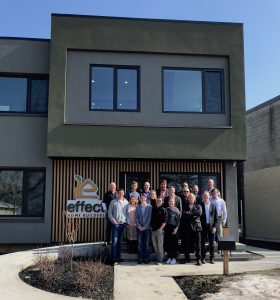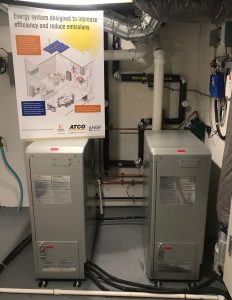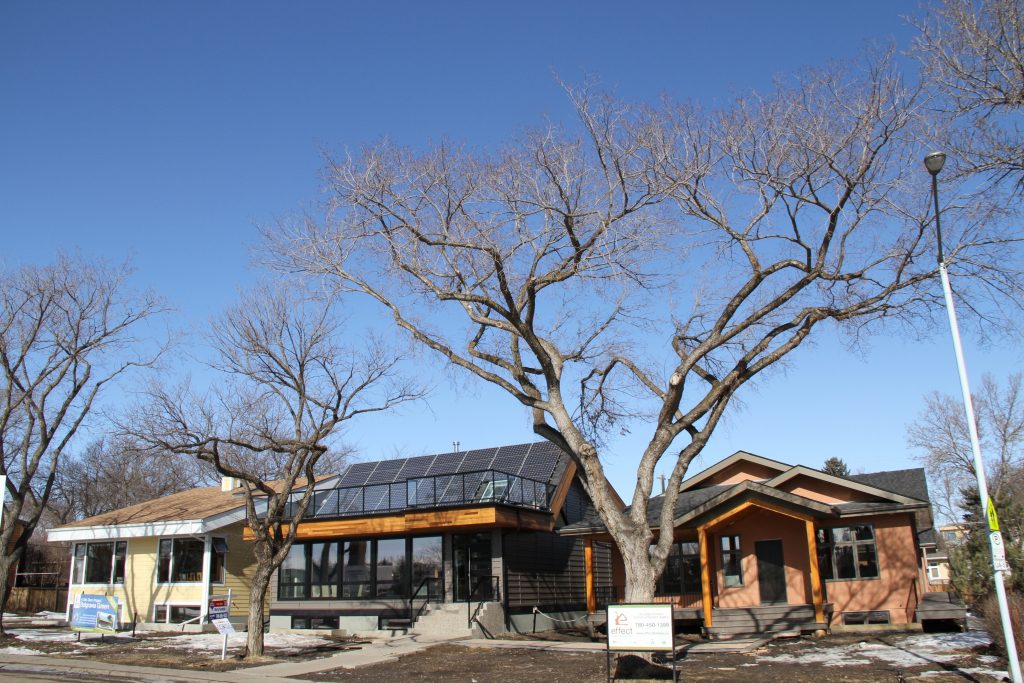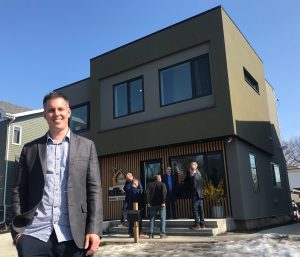By David Dodge and Scott Rollans

Effect Homes, a local leader in building net-zero, solar-powered homes has built Alberta’s first off-grid solar-cogen-powered office.
“Being off the grid means there are no electrical cables from the outside lines into this property,” says Mike Holmes at
the opening of the new self-powered Holmes-approved building. The renovated 2,200 sq. ft. structure, a former residential duplex, now houses Effect Homes’ office.
“We have solar panels that generate the electricity needed for the building and we have six batteries that also store the excess energy to be used later,” explains Les Wold, managing partner with Effect Homes. “And then we have a CoGen system. It’s called a micro combined heat-power unit.”
The building has two 1.5 kilowatt micro-cogeneration units, 4.8 kilowatts of solar, and six 1,000-watt lithium-ion batteries.
How does off-grid solar cogen work?
The system allows the building to have a relatively small solar system (4.8 kilowatts). The smart system uses solar energy first and then calls for electricity from the cogeneration units as needed. All of the electricity is fed into the battery system. The office draws its electricity from the batteries.

Water heated by the cogen units runs through fan coils, where a forced air system distributes the heat throughout the office.
If the batteries are full and it’s sunny out the excess solar energy can be used to heat water to warm the building. There is an electric resistance heating element in the water heater which allows surplus solar energy to be used to heat tap water.
Redundancy is key
The eco-friendly building has already met its ultimate challenge, says Wold. “When we first moved into this office. It was the coldest February in 40 years. And so, it was a good test for the system right off the get-go. And it performed because it was engineered to handle Edmonton’s climate.”
“If anything it’s a little bit overbuilt,” says Wold. “Its two (cogen) units are not always going to be necessary, but when you’re going off the grid you do want to make sure that you’re able to generate the heat and electricity you need on those very deep, cold, dark days, where you’re not getting the sun’s energy.”
An idea for super energy efficient renovations?
The Effect Homes office looks new, but it was a renovation of an old duplex. It’s now super insulated, Wold says. “We used the HP plus wall system, which has actually been engineered by BASF.”

By combining spray foam on the outside of the old foundation and EPS foam insulation on the inside, they were able to squeeze R40 out of the flat ceiling. The new building produces 80 per cent fewer greenhouse gas emissions than the old leaky duplex.
Dale Rott, Effect Homes managing partner, says the combination of solar and cogen they used in this renovation may be especially useful on acreages where it’s expensive to run electricity lines.
Green Energy Futures has done stories on net-zero renovations and it’s not cheap. That said, the potential to create super-efficient renovated buildings could revitalize old neighbourhoods, while increasing efficiency and reducing emissions.
The Effect Homes office is in the heart of the city and this offers other sustainability benefits.
“Put this in a downtown core, where it is, and keep it as a workspace, and you actually inspire people to commute with the bicycle rather than their car,” says Holmes.
Off which grid?
In this case off-grid means off the electricity grid. But the solar-cogen powered office is still connected to the natural gas grid.

Effect Homes is also a leader in building solar-powered, net-zero homes that produce as much electricity as they consume. These homes are connected to the electricity grid, but disconnected from the natural gas grid. This enables the net-zero homes to export surplus electricity on sunny summer days and import electricity during snowy, short winter days.
By eliminating one grid—either gas or electricity—you eliminate one complete set of transmission, distribution, administration and other charges. That can really add up.
By severing itself from the electrical grid, the Effect Homes office offers a new twist on renovating existing buildings to create modern, efficient, low-emissions places to live and work.


